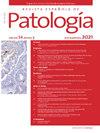Diagnostic utility of bronchoalveolar lavage in pulmonary disorders
IF 0.5
Q4 Medicine
引用次数: 0
Abstract
Background
Pulmonary diseases represent a significant global health challenge, underscoring the need for accurate diagnostic methods to ensure effective management. Bronchoalveolar lavage (BAL) is an essential diagnostic tool, providing valuable insights into various lung conditions. However, despite its widespread application in pulmonology, limited studies have thoroughly evaluated its diagnostic value.
Materials and methods
A retrospective cohort study was conducted over one year to assess the diagnostic utility of BAL. Samples were obtained from patients undergoing BAL as part of their diagnostic workup. Demographic and clinicoradiological data were documented. The BAL fluids were processed and evaluated cytologically, with samples classified into diagnostic categories. In malignant cases, histopathological correlation was performed.
Results
A total of 187 BAL fluid samples were analysed, yielding diagnoses that included malignancy (7%), specific infections (6%), inflammatory conditions (43%), and others. BAL demonstrated high efficacy in identifying malignancies (PPV: 85%) and specific infections such as tuberculosis and fungal pneumonia. Histological correlation confirmed the diagnostic accuracy of BAL in malignancies, with a concordance rate of 78%.
Conclusion
BAL has proven to be a reliable method for detecting both neoplastic and non-neoplastic lung lesions. Its minimally invasive nature makes it a preferred alternative to needle biopsies, particularly in critically ill patients. Even when findings are nonspecific, BAL helps narrow down differential diagnoses. Additionally, the samples obtained can be used for molecular and microbiological analyses, further enhancing its diagnostic capabilities.
支气管肺泡灌洗在肺部疾病中的诊断价值
肺部疾病是一项重大的全球健康挑战,强调需要准确的诊断方法来确保有效的管理。支气管肺泡灌洗(BAL)是一种重要的诊断工具,为各种肺部疾病提供了有价值的见解。然而,尽管它在肺病学中广泛应用,但很少有研究彻底评估其诊断价值。材料和方法进行了一项为期一年的回顾性队列研究,以评估BAL的诊断价值。样本来自接受BAL治疗的患者,作为诊断检查的一部分。记录了人口统计学和临床放射学数据。对BAL液进行处理和细胞学评估,并将样本分类为诊断类别。恶性病例行组织病理学对比。结果共分析了187份BAL液体样本,诊断包括恶性肿瘤(7%)、特异性感染(6%)、炎症(43%)等。BAL在识别恶性肿瘤(PPV: 85%)和特异性感染(如肺结核和真菌性肺炎)方面表现出很高的疗效。组织学相关性证实BAL在恶性肿瘤中的诊断准确性,符合率为78%。结论bal是一种可靠的检测肺肿瘤和非肿瘤病变的方法。其微创性使其成为针活检的首选替代方法,特别是在危重患者中。即使发现是非特异性的,BAL也有助于缩小鉴别诊断的范围。此外,获得的样品可用于分子和微生物分析,进一步提高其诊断能力。
本文章由计算机程序翻译,如有差异,请以英文原文为准。
求助全文
约1分钟内获得全文
求助全文
来源期刊

Revista Espanola de Patologia
Medicine-Pathology and Forensic Medicine
CiteScore
0.90
自引率
0.00%
发文量
53
审稿时长
34 days
 求助内容:
求助内容: 应助结果提醒方式:
应助结果提醒方式:


